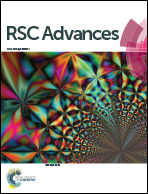Synthesis of a novel glycerol based B3-type monomer and its application in hyperbranched polyester urethane–urea coatings†
Abstract
Glycerol (GLY) based hyperbranched polyester polyols (HBP) were synthesized via the reaction of GLY and succinic anhydride (SA) as a B3-type monomer with GLY as the core moiety without using any solvent. Acid-terminated B3 monomer and HBP were characterized by 1H and 13C nuclear magnetic resonance (NMR) spectroscopy, Fourier transform infra-red (FTIR) spectroscopy, gel permeation chromatography (GPC), differential scanning calorimetry (DSC), and thermogravimetric analysis (TGA). The degree of branching present in HBP was determined by NMR spectroscopy. The HBP was further reacted with different ratios of isophorone diisocyanate (IPDI) to obtain an isocyanate-terminated polyurethane pre-polymer, which was cured under atmospheric moisture to obtain the desired coating films. The thermo-mechanical, viscoelastic and contact angle properties of these films were also evaluated. The glass transition temperatures (Tg) of the cross-linked networks were found to be in the range of 95–125 °C, and the water contact angles were in the range of 78–82°. The Tg and hydrophobic character of the coating films were found to increase with increasing NCO : OH ratio. This study provides an effective and promising way to prepare glycerol based HBPs for obtaining high-performance coatings.


 Please wait while we load your content...
Please wait while we load your content...